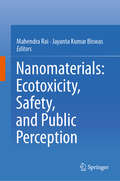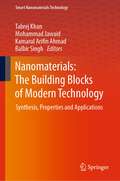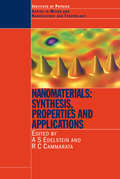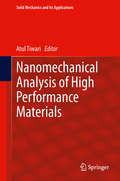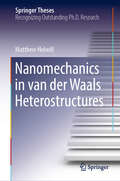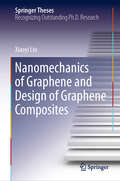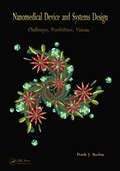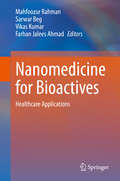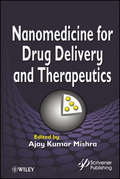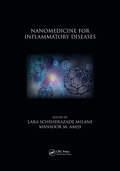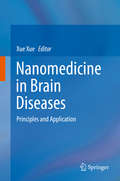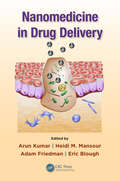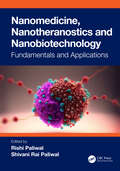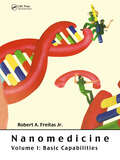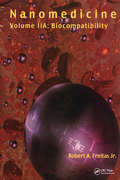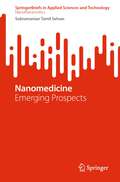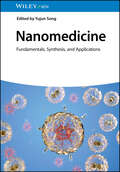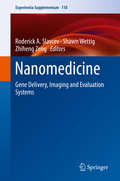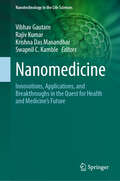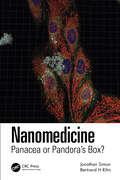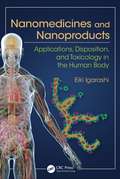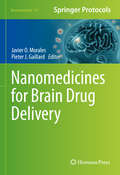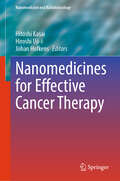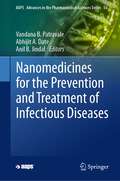- Table View
- List View
Nanomaterials: Ecotoxicity, Safety, and Public Perception
by Mahendra Rai Jayanta Kumar BiswasThe environment is prone to suffer pollution and toxic insult from generations of nanomaterials as well from accidental releases during production, transportation, and disposal operations. The NMs could interact with and cause adverse biological effects at cellular, subcellular, and molecular levels. Assessing potential environmental/ecological risks requires quality information on transport and fate of nanoparticles in the environment, exposures and vulnerabilities of organisms to the nanomaterials and standard methods for assessing toxicity for aquatic or terrestrial organisms and human health. The systematic risk characterization and evaluation of the safety of nanomaterials require a multidisciplinary approach and convergence of knowledge and efforts from researchers and experts from toxicology, biotechnology, materials science, chemistry, physics, engineering, and other branches of life sciences. Although studies are beginning to appear in the literature addressing the toxicity of various nanomaterials and their potential for exposure, at this stage definitive statements regarding the impacts of nanomaterials on human health and the environment remain sketchy requiring an increased level of precautions with regard to nanomaterials, as has happened with other emerging contaminants and technologies (e.g., biotechnology). The need for an increased level of understanding the perception of risk and of benefits will vary and is likely to influence public, regulatory, and non-governmental activities regarding risk and benefit evaluations. Systematic identification and assessment of the risks posed by any new technology are essential. A prudent, integrated, and holistic approach is required to develop best practices based on the scientific understanding about what we know and what we don’t know but need to know. Nanomaterials addresses key issues of ecotoxicological actions and effects of nanomaterials on life and environment, their threats, vulnerability, risks, and public perception. The readers learn to read bad news objectively and think about and search for ecological ‘green’ solutions to current environmental and ecological problems with blue, grey, brown, and red shades for building a sustainable ecosystem. It shows how this molecular terrain is a common ground for interdisciplinary research and education that will be an essential component of science, engineering and technology in the future. The book is divided into three sections. Section I includes general topics related to ecotoxicity of nanomaterials to microbes, plants, human and environment. Section 2 incorporates risks generated by the use of nanomaterials. Section 3 discusss safety issues and the public.
Nanomaterials: Synthesis, Properties and Applications (Smart Nanomaterials Technology)
by Mohammad Jawaid Tabrej Khan Kamarul Arifin Ahmad Balbir SinghThis book provides a general overview of different classes of nanomaterials, which includes the synthesis, fabrication, characterization, properties and technological applications of these materials. The book covers 4 main types of nanomaterials, namely: A) soft nanomaterials, B) biological nanomaterials, C) composite nanomaterials and D) green nanomaterials, where for each nanomaterials, a complete guide to material synthesis, characterization, their unique properties (as compared to a conventional bulk material) and potential technological applications is presented. One of the book's most notable characteristics is the inclusion of a section, a special focus on the future of nanomaterials for next-generation technology in electronic, power and energy devices. The content of this book is presented in a simple and lucid style which can also be used by professionals, scientists and students who are interested in the general research area of nanomaterials technology.
Nanomaterials: Synthesis, Properties and Applications, Second Edition
by A S Edelstein R C CammarataNanomaterials: Synthesis, Properties and Applications provides a comprehensive introduction to nanomaterials, from how to make them to example properties, processing techniques, and applications. Contributions by leading international researchers and teachers in academic, government, and industrial institutions in nanomaterials provide an accessibl
Nanomechanical Analysis of High Performance Materials
by Atul TiwariThis book is intended for researchers who are interested in investigating the nanomechanical properties of materials using advanced instrumentation techniques. The chapters of the book are written in an easy-to-follow format, just like solved examples. The book comprehensively covers a broad range of materials such as polymers, ceramics, hybrids, biomaterials, metal oxides, nanoparticles, minerals, carbon nanotubes and welded joints. Each chapter describes the application of techniques on the selected material and also mentions the methodology adopted for the extraction of information from the raw data. This is a unique book in which both equipment manufacturers and equipment users have contributed chapters. Novices will learn the techniques directly from the inventors and senior researchers will gain in-depth information on the new technologies that are suitable for advanced analysis. On one hand, fundamental concepts that are needed to understand the nanomechanical behavior of materials is included in the introductory part of the book. On the other, dedicated chapters describe the utilization of advanced numerical modeling in understanding the properties of complex materials. I am sure that students and researchers from diverse backgrounds including chemistry, physics, materials science & engineering, biotechnology and biomedical engineering will find this book useful. It is well suited as a textbook for students and also as a reference book for researchers.
Nanomechanics in van der Waals Heterostructures (Springer Theses)
by Matthew HolwillMicro/nano-mechanical systems are a crucial part of the modern world providing a plethora of sensing and actuation functionalities used in everything from the largest cargo ships to the smallest hand-held electronics; from the most advanced scientific and medical equipment to the simplest household items. Over the past few decades, the processes used to produce these devices have improved, supporting dramatic reductions in size, but there are fundamental limits to this trend that require a new production paradigm.The 2004 discovery of graphene ushered in a new era of condensed matter physics research, that of two-dimensional materials. Being only a few atomic layers thick, this new class of materials exhibit unprecedented mechanical strength and flexibility and can couple to electric, magnetic and optical signals. Additionally, they can be combined to form van der Waals heterostructures in an almost limitless number of ways. They are thus ideal candidates to reduce the size and extend the capabilities of traditional micro/nano-mechanical systems and are poised to redefine the technological sphere.This thesis attempts to develop the framework and protocols required to produce and characterise micro/nano-mechanical devices made from two-dimensional materials. Graphene and its insulating analogue, hexagonal boron nitride, are the most widely studied materials and their heterostructures are used as the test-bed for potential device architectures and capabilities. Interlayer friction, electro-mechanical actuation and surface reconstruction are some of the key phenomena investigated in this work.
Nanomechanics of Graphene and Design of Graphene Composites (Springer Theses)
by Xiaoyi LiuThis book addresses several important issues concerning the nanomechanics of graphene, an area that is vital to a fundamental understanding of graphene deformation, and to the design of graphene-related materials. The content chiefly focuses on the out-of-plane mechanical behaviors of graphene, and their effects on the mechanical properties of graphene composites. In addition, the book puts forward original theoretical mechanical models based on continuum mechanics, discontinuous effects and atomistic simulations. The findings presented here can provide the basis for valuable guidelines on the design and application of graphene and graphene composites in the field of nanomechanics.
Nanomedical Device and Systems Design: Challenges, Possibilities, Visions
by Frank J. BoehmNanomedical Device and Systems Design: Challenges, Possibilities, Visions serves as a preliminary guide toward the inspiration of specific investigative pathways that may lead to meaningful discourse and significant advances in nanomedicine/nanotechnology. This volume articulates the development and implementation of beneficial advanced nanomedical diagnostic and therapeutic devices and systems, which may have strong potential toward enabling myriad paradigm shifts in the field of medicine. In addition, it presents conceptual and laboratory-derived examples of how sophisticated, highly efficient, minimally invasive, and cost-effective nanomedical diagnostic and therapeutic strategies might facilitate significantly increased accessibility to advanced medical procedures to assist those in both the developing and developed worlds. Explorations of nanomedicine in human augmentation, longevity and space travel are also undertaken.
Nanomedicine for Bioactives: Healthcare applications
by Vikas Kumar Sarwar Beg Mahfoozur Rahman Farhan Jalees AhmadNanotechnology is opening up new avenues in all scientific and technological fields. Among the novel applications, bioactives and nutraceuticals are fast-growing areas of nano research for better healthcare solutions. A variety of nanoformulations, such as polymeric nanoparticles, nanocapsules, nanoemulsions, transferosomes and ethosomes, liposomes, lipospheres, and lipid polymer hybrid nanoparticles have proved valuable in bioactive delivery and food materials. Further, new herbal drugs and nutraceuticals are reported to have remarkable advantages over conventional formulations of plant actives and extracts, including enhanced solubility, bioavailability, multiple drug delivery, greater stability, sustained delivery, improved tissue macrophage distribution, protection from toxicity, enhancement of pharmacological activity and protection from physical and chemical degradation. This book focuses on the advanced nanomaterials that are utilized for the encapsulation of nutrients/vitamin/phytoconstituents, as well as their other healthcare benefits.
Nanomedicine for Drug Delivery and Therapeutics
by Ajay Kumar MishraThis book describes a broad area of nanomedicine which involves mainly applications, diseases, and diagnostics. The comprehensive coverage provides researchers, academics, and health specialists with a great tool, that includes techniques applicable to various uses.
Nanomedicine for Inflammatory Diseases
by Lara Scheherazade Milane Mansoor M. AmijiNanomedicine for Inflammatory Diseases is a cutting-edge resource for clinicians and scientists alike, working at the intersection of development and clinical therapeutics. This text is ideal for graduate level courses in nanomedicine, translational medicine, or inflammatory disease. <P><P>This book is a progressive hallmark in translational medicine as it unites clinicians treating inflammatory disease with scientists developing experimental nanomedicine therapeutics. The commonality is made through a translational nanomedicine expert – bridging the gap between the laboratory benchtop and the clinical bedside.
Nanomedicine in Brain Diseases: Principles and Application
by Xue XueThis book provides an overview of the current applications of nanomaterials in brain diseases, and introduces several novel nanomaterials that have excellent potential in this field. During the last two decades, nanotechnology had matured significantly as it has transitioned from a bench-top science to an applied technology. However, the application of nanomaterials in basic and clinical neuroscience is still at an early stage, and understanding how the intrinsic properties of nanomaterials translate to complex biological responses is an area of intensive research. Part 1 of the book focuses on the principles and strategies of nanomedicine in the brain diseases, while part 2 examines the applications of promising nanomaterials for therapy and diagnosis in the brain. Together they offer a comprehensive picture of advances in nanotechnology and their successful use in treating brain diseases in the past 20 years.
Nanomedicine in Drug Delivery
by Adam Friedman Heidi M. Mansour Arun Kumar Eric R. BloughThere is a clear need for innovative technologies to improve the delivery of therapeutic and diagnostic agents in the body. Recent breakthroughs in nanomedicine are now making it possible to deliver drugs and therapeutic proteins to local areas of disease or tumors to maximize clinical benefit while limiting unwanted side effects. Nanomedicine in D
Nanomedicine, Nanotheranostics and Nanobiotechnology: Fundamentals and Applications
by Rishi Paliwal Shivani Rai PaliwalNanosized particles explored for therapeutics and diagnosis-related research areas need the latest updated information for budding researchers as well as academicians. Nanomedicine, nanotheranostics, and nanobiotechnology have been contemporary technological tools for diverse biomedical, pharmaceutical, and diagnostic solutions. The present book is divided into two sections.The first section is dedicated to exclusive book chapters related to nanomedicine such as its history, regulatory aspects, scale-up, and regulatory toxicology. Additionally, this section includes chapters focusing on the application domain of nanomedicine for targeted cancer therapy, rheumatoid arthritis management, psoriasis treatment, ocular delivery, topical applications, oral bioavailability enhancement, and pulmonary delivery.The second section is composed of chapters in the area of nanotheranostics and applications of nanobiotechnology. In brief, the latest topics such as gold nanoparticles in diagnostics and therapy, nanoparticles for siRNA delivery, carbon nanotubes for gene delivery, nanoparticles for vaccine delivery, nanobiotechnology in cell-based nanomedicines, nanotechnology in regenerative medicine, and nanocarriers in delivery of proteins and peptides are complied.KEY FEATURES A total of 26 emerging topics are covered in the book on cutting-edge research areas at the multi-disciplinary level. The chapters focus on fundamentals and applications, making the book attractive for beginners as well as experts. The chapters are written by well-known experts of the field in a simple scientific style with figures, schemes, and illustrations.
Nanomedicine, Volume I: Basic Capabilities
by Robert A. FreitasMolecular nanotechnology has been defined as the three-dimensional positional control of molecular structure to create materials and devices to molecular precision. The human body is comprised of molecules, hence the availability of molecular nanotechnology will permit dramatic progress in human medical services. More than just an extension of "molecular medicine," nanomedicine will employ molecular machine systems to address medical problems, and will use molecular knowledge to maintain and improve human health at the molecular scale. Nanomedicine will have extraordinary and far-reaching implications for the medical profession, for the definition of disease, for the diagnosis and treatment of medical conditions including aging, for our very personal relationships with our own bodies and ultimately for the improvement and extension of natural human biological structure and function. This book will be published in three volumes over the course of several years. Readers wishing to keep up-to-date with the latest developments may visit the nanomedicine website maintained by the Foresight Institute (http://foresight.org/Nanomedicine/index.html).
Nanomedicine, Volume IIA: Biocompatibility
by Robert A. FreitasThe safety, effectiveness, and utility of medical nanorobotic devices will critically depend upon their biocompatibility with human organs, tissues, cells, and biochemical systems. In this Volume, we broaden the definition of nanomedical biocompatibility to include all of the mechanical, physiological, immunological, cytological, and biochemical re
Nanomedicine: A Soft Matter Perspective
by Dipanjan PanThe unprecedented potential of nanotechnology for early detection, diagnosis, and personalized treatment of diseases has found application in every biomedical imaging modality. However, with the increasing concern about the ethical and toxicity issues associated with some "nanoplatforms," biomedical researchers are in pursuit of safer, more precise
Nanomedicine: Emerging Prospects (SpringerBriefs in Applied Sciences and Technology)
by Subramanian Tamil SelvanThis book highlights the emerging paradigm of nanomedicine, intersecting two burgeoning fields of nanotechnology and medicine. Numerous publications have appeared in the literature over the years, especially in cancer nanomedicine. In a boarder sense, nanomedicine aims to apply the knowledge and tools of nanotechnology in a mission to diagnose early and prevent or treat diseases using biocompatible nanoparticles (NPs). Current research in nanomedicine and its prospects depend on creating new breakthroughs at the nexus of nanomaterials and biological systems, making use of non-toxic NPs and nano/biomaterials as smart theranostic systems for a variety of diseases including cancer, neurodegenerative, orthopedic, and cardiac diseases. This book provides a review on recent advancements of nanomedicine in the aforementioned emerging areas of nanomedicine.
Nanomedicine: Fundamentals, Synthesis, and Applications
by Yujun SongA comprehensive and multidisciplinary guide to nanomaterials-based medicine Nanomedicine is the study and application of nanomaterials-based medical techniques. In recent years it has very rapidly become indispensable in a huge range of medical contexts, from analysis of extreme life events to diagnosis and treatment of life-threatening intractable diseases, such as cancers and cardiovascular diseases. It has already transformed both research and clinical outcomes in many areas of medicine and promises to continue as the cutting-edge research and clinical area for the next generation of medical specialists. Nanomedicine: Fundamentals, Synthesis, and Applications constitutes a comprehensive guide to this subfield and its recent advances. Beginning with a brief history of the field and introduction to its core principles, it thoroughly treats recent developments in this vital and ever-growing field. Its multidisciplinary approach equips the reader with a systematic overview of these life-saving developments in medicine. Nanomedicine readers will also find: Edited by a leading researcher with decades of experience in both North America and ChinaDetailed treatment of subjects including nanocarriers, nanomaterial bioprobes, multi-function nanodrugs, nanomedicine-mediated immunotherapy and/or physical ablation, and moreA comprehensive volume treats every facet of the subject Nanomedicine is a vital resource for biochemists, biomedical engineers, pharmaceutical chemists, physicists, and professionals in the biotechnological industries, as well as for clinicians looking to familiarize themselves with nanomedical techniques and instrumentation.
Nanomedicine: Gene Delivery, Imaging and Evaluation Systems (Experientia Supplementum #110)
by Roderick A. Slavcev Shawn Wettig Zhiheng ZengThis work was compiled to serve as a convenient source that covers a number of techniques (and details of their use) in the rather large field of nanomedicine, with special attention paid to gene delivery. As principal investigators working in the field of nanomedicine, we sought to put together the most current and relevant topics in gene delivery, imaging and evaluation systems. We expect the work to serve very well for scientists and graduate students in the nanomedicine field.
Nanomedicine: Innovations, Applications, and Breakthroughs in the Quest for Health and Medicine's Future (Nanotechnology in the Life Sciences)
by Rajiv Kumar Vibhav Gautam Krishna Das Manandhar Swapnil C. KambleNanotechnology is revolutionizing healthcare, by providing innovative solutions to some of the most challenging issues in medicine. This book provides an in-depth overview of nanoscale materials and devices that are advancing diagnostics, therapeutics, and personalized care in medical field. It focuses on nanomedicine’s impact on vaccine efficacy as well as innovative diagnosis and therapy for various type of cancer while addressing concerns about safety and toxicity. It examines how nanotechnology is enhancing drug delivery by precisely targeting medicines to specific cells or tissues, thereby increasing treatment efficacy with reduced side effects. This book also explores how nanoparticles are advancing medical imaging for earlier and more accurate disease detection, and how nanosensors allow real-time biomarker monitoring for faster and more reliable diagnoses. Additionally, it explores nanomedicine's role in managing cardiovascular diseases, improving bone health through nano-extracellular vesicles, and regenerative medicine, including ongoing clinical trials and ethical considerations. This book is an essential resource for researchers, practitioners, and students, offering a comprehensive exploration of nanomedicine’s role in shaping the future of health and medicine leading to a new era of precision medicine and improved patient care.
Nanomedicine: Panacea or Pandora's Box?
by Jonathan Simon Bertrand H. RihnThe book is an introduction to nanomedicine informed by a philosophical reflection about the domain and recent developments. It is an overview of the field, sketching out the main areas of current investment and research. The authors present some case-studies illustrating the different areas of research (nanopharmacy, theranostics and patient monitoring) as well as reflecting on the risks that accompany it, such as unanticipated impacts on human health and environmental toxicity. This introduction to a fast-growing field in modern medical research is of great interest to researchers working in many disciplines as well as the general public. In addition to an overview of the work currently ongoing, the authors critically assess these projects from an ethical and philosophical perspective. Key Features Provides an overview of nanomedicine Employs a reflective and coherent critical evaluation of the benefits and risks of nanomedicine Written in an accessible manner intended for a wide audience Related Titles Hehenberger, M. Nanomedicine: Science, Business, and impact (ISBN 978-9-8146-1376-7). Beg, S., et al. Nanomedicine for the treatment of Disease: From Concept to Application (ISBN 978-1-7746-3443-1) Brenner, S. The Clinical Nanomedicine Handbook (ISBN 978-1-1380-7578-8)
Nanomedicines and Nanoproducts: Applications, Disposition, and Toxicology in the Human Body
by Eiki IgarashiNanomedicines and Nanoproducts: Applications, Disposition, and Toxicology in the Human Body provides a detailed overview of the disposition of nanoproducts within the body, with a special focus on the respiratory and olfactory routes of nanoproduct administration, buccal exposure and the ingestion of nanoproducts, the integumentary system (formed by the skin, hair, nails, and associated glands), the ocular route, the systemic route, and toxicology as it relates to the nanoscale world.Offering an interdisciplinary, big-picture view of the current and future state of nanotechnology, this book: Identifies key points for the entry of nanoproducts, nanomedicines, and other nanoscale structures into the body Reviews the bodily administration and subsequent disposition of nanoproducts via various exposure routes Describes the intravenous route of administration for the therapeutic management of ocular disease Discusses practical nanoproduct and nanomedicine applications, disposition, and toxicology Summarizes various toxicological principles and the testing of nanoproducts Nanomedicines and Nanoproducts: Applications, Disposition, and Toxicology in the Human Body addresses the scope of practical nanoparticle applications in academic research as well as industrial investigation, where "practical" is defined as advantageous in all aspects of nanoproduct disposition, efficacy, and toxicology. The book’s goal is to introduce potentially beneficial applications and exciting topics regarding nanoproducts to a variety of professional and general readers.
Nanomedicines for Brain Drug Delivery (Neuromethods #157)
by Javier O. Morales Pieter J. GaillardThis volume explores the latest research in central nervous system (CNS) targeted nanocarriers, methods for their synthesis, and its characterization process. Chapters in this book cover topics such as polymeric nanoparticles and liposomes; self-assembled peptide-based scaffolds for lesions of the nervous system; use of peptides as CNS drugs and as potential carriers to optimize brain-targeted delivery; ways to model and assess blood brain barrier absorption of drugs; and the role of neurodegeneration progress of nanomaterials and their potential toxicity concerns. In the Neuromethods series style, chapters include the kind of detail and key advice from the specialists needed to get successful results in your laboratory.Thorough and cutting-edge, Nanomedicines for Brain Drug Delivery is a valuable resource that will help researchers guide and advance the field of nanomedicines for the brain and nervous system.
Nanomedicines for Effective Cancer Therapy (Nanomedicine and Nanotoxicology)
by Johan Hofkens Hitoshi Kasai Hiroshi Uji-IThis book describes in detail the most up-to-date designs and fabrication techniques for nanomedicines toward effective cancer therapy, while especially emphasizing the biological interaction of nanomedicines at the cellular level, through comprehensive and visual cutting-edge technologies. Unlike other books on the general subject of medicine or drug delivery, this book provides readers the comprehensive information regarding what happens to the nanomedicine at the cell membrane surface, uptake mechanism, and what biochemical process it undergoes inside the cellular matrix. This full overview of the interaction between nanomedicines and cells also provides insights of how to design nanomedicines for effective cancer therapy.
Nanomedicines for the Prevention and Treatment of Infectious Diseases (AAPS Advances in the Pharmaceutical Sciences Series #56)
by Vandana B. Patravale Anil B. Jindal Abhijit A. DateThe COVID-19 pandemic has altered the world and reiterated the perpetual need for the development of effective strategies for the prevention and treatment of infectious diseases. While globally prevalent infectious diseases receive extensive attention in terms of drug development and delivery, the neglected and/or emerging infectious diseases that affect developing countries are often overlooked. Additionally, the therapeutic efficacy of existing anti-infective agents is often limited due to sub-optimal biopharmaceutical properties, sub-therapeutic levels of the drugs at the infection site due to various physiological barriers, the expulsion of the drug by efflux transporters, and the emergence of drug-resistant strains.From the commercialization of AmBisome® to the emergency authorization of mRNA-based vaccines, nanotechnology has played a vital role in the prevention and treatment of infectious diseases. More importantly, nanotechnology has enabled the effective utilization of existing armamentarium against infectious diseases leading to improved therapeutic outcomes with a concomitant reduction in the side effects associated with anti-infective agents. In particular, nanotechnology can bring about a paradigm shift in the management of neglected and emerging infectious diseases and may compensate for the lack of drug discovery efforts. While there are several books dedicated to pharmaceutical and/or biomedical applications of nanotechnology or nanotechnology for cancer therapy a comprehensive book focusing on the prevention and/or treatment of viral, bacterial, fungal, and parasitic infections is not available. This book addresses an unmet need in pharmaceutical and medical education.This book provides a comprehensive and up-to-date overview of the latest advancements in nanomedicine, which show great potential for preventing and treating infectious diseases. Covering a wide range of topics, it explores various formulation strategies for combating microbial, fungal, parasitic, and viral infections. The book emphasizes the advantages of nano-scale vaccines over traditional ones and discusses their production. It also examines feasible treatment approaches for diseases like malaria, trypanosomiasis, candidiasis, Hepatitis B, HIV, and the ongoing COVID-19 pandemic. Additionally, it highlights the role of nano-adjuvants in vaccine development, as well as the use of peptide antibiotics and pulmonary delivery of drugs, which open up new possibilities in fighting infectious diseases. Furthermore, the book explores the critical role of nanomedicine in addressing veterinary parasitic infections. The emergence of nanotechnology has led to novel strategies for diagnosing, treating, and preventing parasitic infections in animals.In summary, this book offers a comprehensive description of clinically viable and investigational nanotechnology-enabled medicines (nanomedicines) for the prevention and treatment of globally prevalent, neglected, and emerging infectious diseases.
